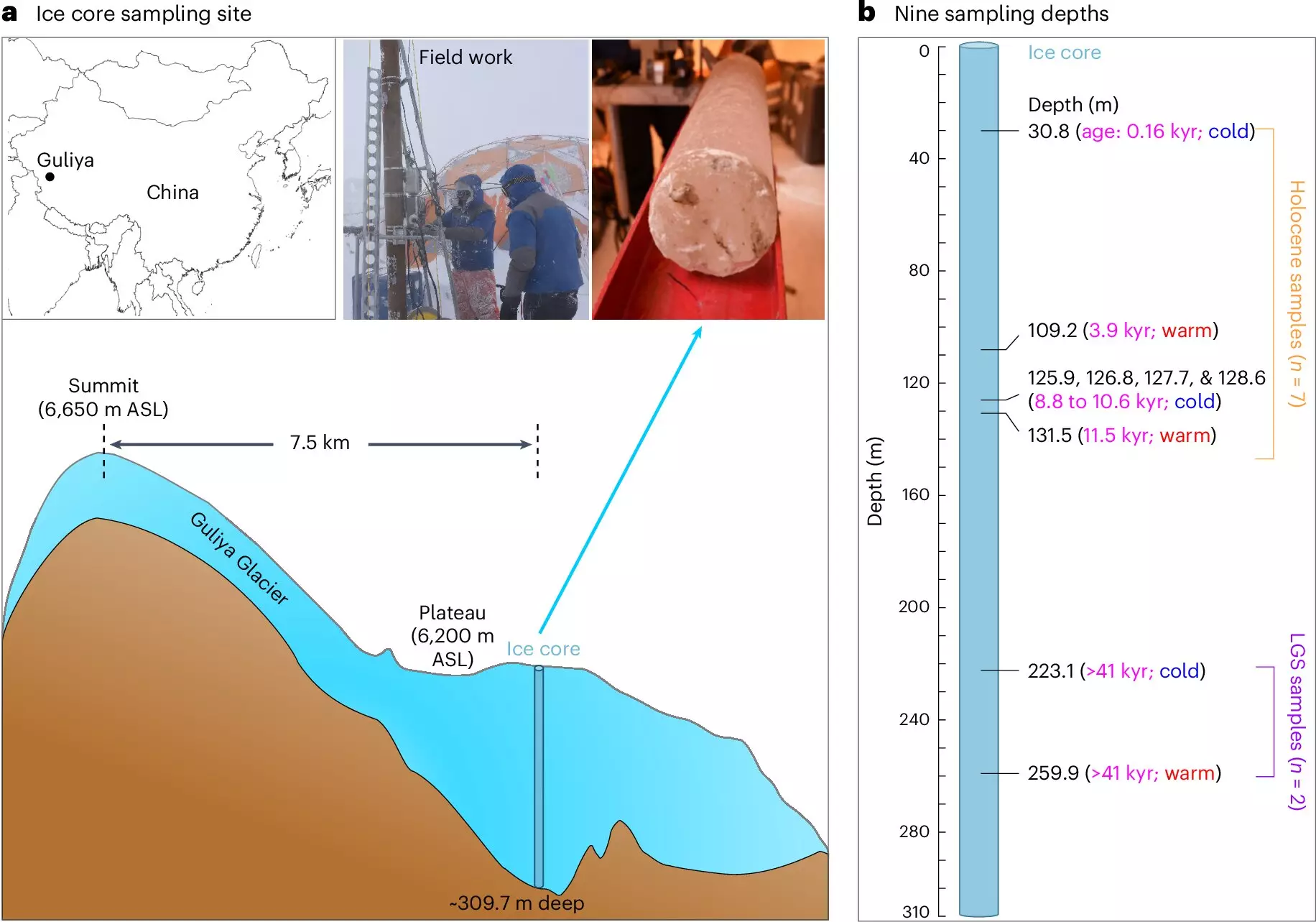Recent studies have shed light on the remarkable potential that ancient viruses encapsulated in glacial ice hold for understanding past climate dynamics. The Guliya Glacier, towering above 20,000 feet in the remote reaches of the Tibetan Plateau, has evolved into a scientific treasure trove. This natural archive reveals crucial data regarding climatic shifts over millennia. As glaciers worldwide recede rapidly due to ongoing climate change, the race to extract and analyze these frozen remnants intensifies, presenting both an opportunity and a looming deadline for researchers.
In an innovative study published in *Nature Geoscience*, microbiologists meticulously examined core samples from the Guliya Glacier, unveiling nearly 1,700 viral species trapped in the ice, of which approximately 75% had never been identified before. This groundbreaking discovery challenges previous assumptions about the role of viruses in historical ecosystems. According to Dr. ZhiPing Zhong, the lead author of the study, these ancient viruses have been crucial in understanding past environmental conditions. “Before this work, how viruses linked to large-scale changes in Earth’s climate had remained largely uninvestigated,” he acknowledged, emphasizing the significance of these findings in piecing together the Earth’s climatic narrative.
By using advanced sequencing technologies to analyze viral DNA, scientists discovered that many of these viruses had adapted to their host microbes, possibly influencing their resilience amid extreme climatic variations. The study supports emerging theories that suggest viruses could play a pivotal role in microbial evolution in response to shifting environmental conditions, thus highlighting a complex interplay between viral species and their hosts throughout geological history.
One of the most intriguing aspects of this research is the potential connection between viral activity and climate fluctuations. The team identified distinct viral communities dating back approximately 11,500 years, a transformative epoch when the Earth transitioned from the cold, harsh Last Glacial Stage into the warmer Holocene period. This era alignment implies that microorganisms were responding to significant climatic shifts, suggesting a dynamic ecosystem reacting to environmental changes. However, establishing a direct causal relationship remains an intricate challenge.
Zhong cautioned against drawing definitive conclusions too early but recognized the preliminary evidence indicating that viral evolution is linked to climatic changes. This emergent paradigm underscores the necessity for further research into the ecological ramifications of viruses and their long-term impact on global climatic events. Understanding this relationship is critical, as it could illuminate how contemporary viruses may respond to ongoing climate trends.
The implications of these findings extend far beyond Earth’s climatic history; they may also influence the way scientists approach the search for extraterrestrial life. The research conducted in glacial ice provides a robust framework for understanding how life can survive in extreme conditions, offering invaluable insights for future astrobiological explorations on planets like Mars, where icy environments may harbor microbial life beneath their surfaces.
Dr. Lonnie Thompson, a co-author of the study, articulated this perspective profoundly, stating that the techniques developed through their research could aid in searching for life in the frigid expanses of space. This multifaceted exploration of ancient viral DNA may reveal metabolic pathways and microbial behaviors that could exist in alien environments, paving the way for groundbreaking discoveries in astrobiology.
The success of this study hinges on the collaborative efforts of various scientific disciplines. According to Matthew Sullivan, another co-author, the interdisciplinary integration facilitated by Ohio State University’s Byrd Polar and Climate Research Center and the Center of Microbiome Science has been vital in advancing this research. The merging of different scientific languages and methodologies has fostered an innovative environment where ground-breaking explorations into ancient ice have flourished.
However, these efforts must be executed quickly, as rapid warming continues to threaten the glaciers that harbor these ancient secrets. The researchers are advocating for continued investment in both technological advancements and interdisciplinary research methodologies to maximize the potential of studying ancient viruses before the ice containing them disappears.
The ancient viruses preserved in glacial ice may offer critical insights into both our planet’s history and the future of ecosystems under climate change. With the alarming rate of glacier melt, the urgency for collection and analysis cannot be understated. As scientists unlock the secrets of these long-dormant organisms, they forge tools that could enhance our understanding of ecological resilience and adaptation, equipping us to face the challenges posed by our rapidly changing world. The race is on—not just to study the past but to inform our survival strategies moving forward.

